The Luxury of Risk: Helping People Afford to Pursue Their Dreams Again
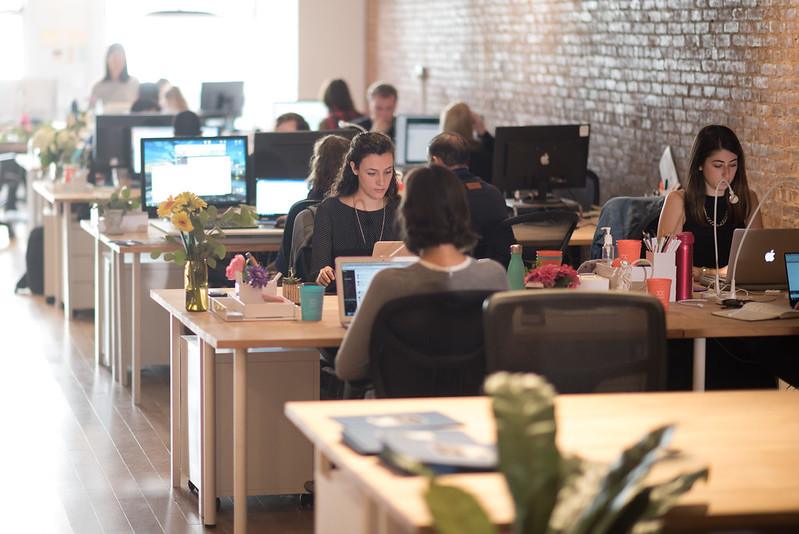
An opportunity for workers in an old law (photo: Michael Appleton/Mayor's Office)
As several cities begin to shutdown again with the hope of slowing the spread of COVID-19, we’re reminded of the timeless words “certain unalienable rights, that among these are life, liberty and the pursuit of happiness.” I’m interested in the unique opportunity to evaluate how that third unalienable right — the pursuit of happiness — matches with the reality of today’s world and steps we can take to improve opportunities for people to pursue and achieve their definition of happiness.
For Americans, it has become increasingly difficult to feel content, optimistic, and fulfilled during this period of uncertainty and tragedy. While happiness is of course subjective, research shows that only 49% of Americans are very satisfied with their job while an even more shocking 14% of Americans report being generally “very happy.” There is a clear culprit that makes this pursuit of happiness difficult for many: lack of financial security.
There is plenty of evidence to suggest that money cannot buy everlasting happiness, but there are also strong correlations between rising incomes and a certain level of happiness. Not having enough income to cover basic needs can contribute to unhappiness and general dissatisfaction (not to mention the negative correlation with overall health).
For many, being able to pursue a better life is dependent on the ability to take on certain risks. One’s ability to start a new job, go back to school, launch a business, or even spend more time on a new hobby does not happen in a vacuum. Those who are struggling to pay their basic bills every month do not have the financial freedom to take these kinds of risks. Yet there is hope.
New York City has just announced an ambitious initiative, Employee Ownership NYC, that will help more employees of small businesses in the city to become owners — and also help infuse struggling businesses with capital and resources to be able to sustain themselves through the duration of this pandemic.
At the same time, as more and more Americans work for large companies, there is a tremendous opportunity to help even more people realize financial security, especially women and people of color.
Written into law in 1964, the Employee Stock Purchase Plan (ESPP) was created as part of President Lyndon Johnson’s War on Poverty. Effectively, it was America’s first financial wellness benefit and today it still holds incredible promise to help Americans build sustainable wealth and secure their financial futures.
Under the original law, employees could contribute up to $25,000 per year to purchase company stock at a discount. Although the $25,000 limit has never been updated to reflect inflation over more than 50 years, the value of these programs for hardworking Americans is incredibly powerful.
Around half of America’s publicly-traded companies offer ESPPs, which means millions of Americans have direct access to the wealth-building power of the stock market—at a discount—through their employers. Well-run, financially-inclusive ESPPs can help employees generate what can be equated to an 11% annual raise.
Despite this, participation in ESPPs remains incredibly low because the reality of affording access to this benefit can be out of grasp for many. Companies need to harness the power of technology and innovation to make these plans accessible to all of their employees, not just the ones that can afford to reduce their take-home pay in order to participate. It is a solution to income inequality that is directly within our grasp.
It’s impossible to talk about income inequality, however, without taking a close look at who’s participating in the stock market today. Recent reporting by the Associated Press found that 61% of white households own stock while in Black households that number is only 33%. The same report noted that the S&P 500 grew approximately 260% over the last decade—meaning for those Americans that are in the market—the last ten years have been quite successful financially.
One of the most impactful ways to get more Americans into the stock market and sustainably close the wealth gap is through employee stock purchase programs coupled with the right financial inclusion tools and education.
By building equity in the companies where they work, American workers can begin to align their interest with the goals and priorities of the decision-makers at the very top of their firms. Research shows that employees who have ownership in the companies where they work are more satisfied and more motivated in their jobs. This also means that employees have access to capital on a rainy day and have the opportunity to make their money work for them.
While stock programs will never take away the need for employees to earn a good living and have access to other crucial benefits like healthcare, ESPPs are one of the few benefits that immediately help employers and employees alike and that don’t require action from Washington or costly changes by companies.
Through ESPPs companies can take book value of their shares—which look good on a balance sheet but do little else—and convert those to cash which can be used to cover any number of business-related expenses. Pair that with a more motivated and committed workforce and the benefit looks even better from an employer perspective.
Through these stock programs we have a proven solution that squarely aligns with the goals and values of both political parties and presents an opportunity to make a huge difference in the lives of working Americans—offering a pathway to more financial freedom, happiness and greater economic opportunity for millions.
***
Aaron Shapiro is the Founder and CEO of New York-based Carver Edison. On Twitter @CarverEdisonHQ.
***
Have an op-ed idea or submission for Gotham Gazette? Email This email address is being protected from spambots. You need JavaScript enabled to view it.
A Green Recovery Plan for New York City
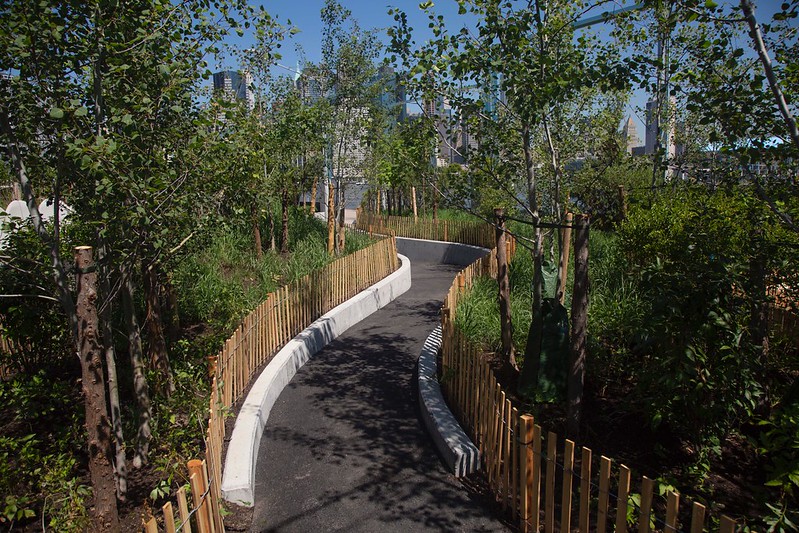
A path to greener pastures (photo: John McCarten/City Council)
As New York City plans for recovery from the COVID-19 pandemic, we must first examine the ways our environmental decisions have contributed to public health abuses in the past and enact a green recovery program that centers the wellbeing of long-ignored communities.
New York City has a long history of environmental racism and injustice. Low-income communities, majority-immigrant communities, and communities of color have borne the burden of severe environmental degradation. Landfills, industrial power plants, waste incinerators and transfer stations, and toxic waste disposal sites are consistently built in lower-income neighborhoods. Data is clear that a person’s zip code is often a greater determinant of health than many genetic predispositions. Yet, due to a lack of political accountability coupled with historically racist zoning and environmental practices, we have repeatedly put the health and wellbeing of fellow New Yorkers at risk.
But we can end this vicious cycle of neglect with effective, comprehensive legislation instead of patchwork solutions.
It’s no secret that the climate crisis is getting worse. But, here in New York, the city’s failure to protect the environment cannot be overstated. Discriminatory city planning initiatives have placed the health of marginalized communities in jeopardy. A lack of access to green energy planning, insufficient neighborhood green spaces, and the effects of toxic waste have led to higher instances of asthma and lead poisoning from Gowanus to Greenpoint.
The scale of contamination in North Brooklyn alone is still being unearthed. Greenpoint, WIlliamsburg, and other parts of the 33rd City Council District are home to multiple federal and state superfund sites and brownfields; and, for decades, residents have felt the massive toxic impacts of these sites in their neighborhoods.. Our communities are also divided by the Brooklyn-Queens Expressway, which has polluted our environment for generations.
Yet, we can still take bold action against these polluters. For years, local environmental advocates have been on the frontlines of neighborhood toxic clean-up and air monitoring initiatives, and have fought tirelessly to hold gas and energy companies accountable for contributing to the district’s disrepair. They need a partner in government.
We must elect legislators who will work with community members to hold toxic polluters accountable, divest from for-profit energy suppliers, and actively work to stop the construction of National Grid’s North Brooklyn Pipeline. Repeatedly, companies like ExxonMobil and National Grid show that they cannot be trusted. We must demand actionable remedies for the harm these companies have caused, and shift to renewable energy. It's time we free ourselves from reliance on fossil fuels. It’s time New Yorkers were in control of their energy — it’s time for public power.
We’ve made progress, but there is still a long way to go toward achieving the green and just New York we need to face the climate crisis head-on.
Foremost, we can commit to creating and expanding a network of open green spaces. This will not only help us meet the challenges of climate change and improve environmental health, but also usher in a new era of safe, efficient, and sustainable transportation in New York. Campaigns like Make Meeker Move and the BQGreen acknowledge the environmental degradation done to Black and Brown communities and seek to take back public space for people.
An investment in open space in neighborhoods that lack parks also creates opportunities for environmental economic growth, and moves us on the urgently needed path away from car-centric infrastructure toward more people-first planning. New protected bike and busways ensure cyclists and pedestrians have safer commuting options; and making the city’s Open Streets program permanent would keep our communities vibrant and help our local businesses thrive in the wake of the COVID-19 pandemic.
In 2012, Hurricane Sandy ripped through our city, causing billions of dollars worth of damage, and lasting harm to residents in public housing. Right now, we are unprepared to handle another hurricane of that magnitude, and our waterfront neighborhoods in Brooklyn need a plan to properly withstand the effects of another deadly storm. We can immediately invest in ‘sponge city infrastructure;’ permeable pavements, green roofs, and cost-effective bioswales in flood prone areas to absorb stormwater and reduce carbon emissions.
Longer-term, we need a comprehensive, citywide resiliency plan and reform of City Environment Quality Review (CEQR) procedures, exploring ways to rezone heavy flood areas as open spaces, create resiliency projects, and increase wetland restoration centers. We also need to build neighborhood energy hubs for storage, and invest in new building energy retrofits. This will create new jobs and we must prioritize communities harmed by environmental racism in hiring.
New York cannot afford to lose more ground in the fight against climate change. These solutions are critical to safeguarding our communities, and will enable us to create a green job corps for COVID recovery.
We must make environmental justice the centerpiece of New York’s economic recovery plan. We need to take an aggressive stance on local and sustainable climate policy, and elect leaders committed to cultivating the future we deserve. It will take work, but we can build this future together.
***
Elizabeth Adams is a Democratic candidate for City Council in District 33, in Brooklyn. Read her full environmental recovery plan here. On Twitter @ElizabAdams.
***
Have an op-ed idea or submission for Gotham Gazette? Email This email address is being protected from spambots. You need JavaScript enabled to view it.
For Climate and Community Protection, It’s Time to Electrify Transportation in New York
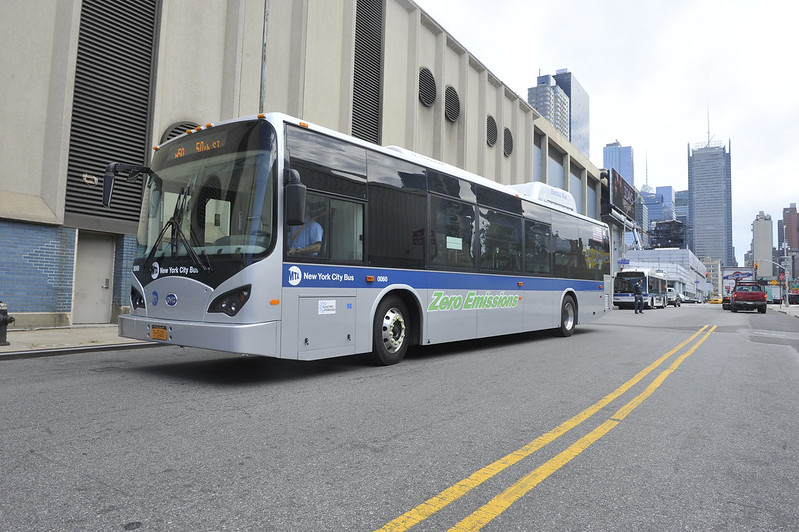
An electric bus (photo: Marc A. Hermann/MTA New York City Transit)
This has been a year of unexpected and devastating loss with the number of deaths from COVID-19 in the United States already surpassing 300,000. In New York City, bus drivers, train operators, and other transit workers have shown up everyday to keep the city moving forward through the spring peak and now into a second wave of infections.
But there is a cost to providing transit services during a pandemic. And the cost is more than 125 MTA workers who have already lost their lives, and thousands more who have been infected and may suffer lifelong health impacts.
What’s most tragic, is that much of this loss was preventable. Partly because our leaders could have managed the pandemic better, but also because air pollution makes the impacts of COVID-19 much worse, and air pollution is largely preventable.
Many bus drivers, train operators, and other transit workers come from the same neighborhoods most impacted by high concentrations of air pollution, the environmental justice communities leading the fight for climate justice.
Air pollution, specifically particulate matter (PM) 2.5, is the largest environmental health risk in the United States, and the Trump EPA just rejected stricter standards despite concerns from the agency’s own scientists. PM 2.5 directly leads to heart problems, respiratory illness like asthma, diabetes, and birth defects. PM 2.5 comes from burning fossil fuels, and in New York, vehicle tailpipe emissions are the number one source of this harmful pollution.
These emissions from cars, trucks, buses, and trains are also the largest contributor to New York State’s greenhouse gas (GHG) emissions, responsible for 36% of the state’s total GHG emissions according to the New York State Energy Research and Development Authority’s inventory.
And, these harmful pollution impacts are even worse near their sources. Roughly one-third of the negative health impacts occur within five miles of the emission source, which means that neighborhoods in heavily-trafficked communities suffer the most.
Studies show that 74% of Black and Latino New Yorkers, and 80% of Asian New Yorkers live in areas where transportation-related PM 2.5 concentrations are higher than the state average. The most polluted Census tract in the Northeast is in the West Bronx, where the population is 99% people of color. By contrast, more than two-thirds of white New Yorkers live in areas that are below the state average.
In response, the ElectrifyNY coalition – in partnership with Assemblymember Jeffrey Dinowitz and Senator Timothy Kennedy – introduced the Green Transit Green Jobs bills to mandate that all transit agencies in New York purchase only zero-emissions vehicles starting no later than the year 2029.
This legislation will help decrease air pollution and protect New Yorkers’ health, while also helping to achieve the GHG emissions reduction goals set by New York’s nation-leading climate law (the Climate Leadership and Community Protection Act). In fact, by transitioning all the buses in New York to zero-emissions electric vehicles, transit agencies would eliminate 900,000 metric tons of CO2 and save approximately $870 million in health costs.
Green Transit Green Jobs also means more local, good-paying jobs because it will encourage electric bus manufacturing in New York and will contribute to the growth of a green economy that no longer exacerbates the risk to public health and our climate. There are 8,500 transit buses in operation throughout the state, and transitioning all of them to electric vehicles will greatly improve the health, environment, and economy of the entire state and its people.
The link between transportation and air pollution is clear, as are the negative impacts of that pollution on public health and the climate. The Green Transit Green Jobs bills give us a roadmap to protect the health of our communities and our climate while prioritizing the equity and environmental justice goals in New York’s climate law.
Bus drivers, subway conductors, and other transit workers have kept New York moving forward through this crisis. We should honor them by putting New York on track to a future with good jobs, healthier communities, and a sustainable climate.
***
Renae Reynolds is Transportation Planner at NYC-Environmental Justice Alliance. Rachel Patterson is Legislative and Climate Associate at Environmental Advocates NY. The Green Transit Green Jobs bills are A9046/S7349 and A10559/S8548. On Twitter @Renae_Rey, @NYCEJAlliance, @greenwatchdogNY & @electrify_ny.
***
Have an op-ed idea or submission for Gotham Gazette? Email This email address is being protected from spambots. You need JavaScript enabled to view it.
A Universal Internet Guarantee to Bridge the Digital Divide for Every New Yorker
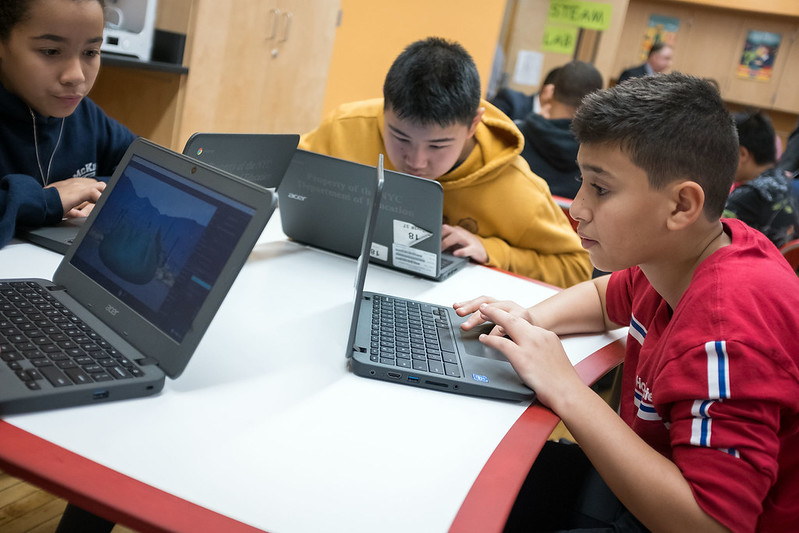
A plan for internet access at school and home (photo: Ed Reed/Mayor's Office)
The coronavirus pandemic has shown all of us the importance of a reliable high-speed home internet connection, whether for remote learning and working from home or for gathering virtually with loved ones. There is a common cliché that “the virus doesn’t discriminate,” but the reality is that coronavirus disproportionately harms low-income communities of color impacted by systemic racism in government and the private sector.
With many households in these communities lacking high-speed internet, the shift to social distancing has been particularly challenging. As we prepare for a second wave, or for the next virus, we must rebuild our society with the guarantee of universal broadband—finally treating the internet as a utility like phone service or electricity. We must use all of New York City’s local regulatory power to deliver on the promise of universal broadband by establishing a Universal Internet Guarantee.
Mayor de Blasio recently took a step in the right direction when he announced $157 million in funding to expand broadband internet access to 600,000 underserved New Yorkers, including 200,000 public housing residents. But New York City’s public housing authority (NYCHA) has 173,762 public housing units, home to 381,159 authorized residents, and this plan could still leave half without internet. More than 1.5 million New Yorkers do not have broadband, and this plan would leave nearly 1 million of them on the wrong side of the ‘digital divide.’
To deliver truly universal broadband, we need several fixes at once. We could start with rezoning to require affordable Mandatory Inclusionary Internet, just like we required affordable housing with Mandatory Inclusionary Housing. We could create incentives for 5G providers to offer affordable access. We can require cable providers to expand affordable internet offerings we already won to every single low-income New Yorker. And if the providers won’t do it, we can take over their networks and do it ourselves by establishing a municipal broadband network.
We can upgrade existing infrastructure by speeding along the conversion of old payphones into free internet kiosks and add WiFi to bus stops. We can even open up the city government’s wireless network to the public.
The pandemic has shown us the importance of giving every public school student who needs one a laptop and affordable broadband in the home to eliminate the ‘homework gap’ (that became a ‘schoolwork gap’ during the pandemic) and give a whole new generation a real chance at equity. Where all else fails, for those we still haven’t reached in low-income communities of color, we must invest the millions promised by the mayor in businesses owned and operated by women and people of color to spur innovation and connect every last New Yorker.
In partnership together, with an eye toward each of our roles in the city’s franchising, we have authored a report that focuses on some of the most important aspects of the digital divide and proposed solutions to help close it and bring us closer to the equitable New York City we need to move toward immediately.
***
Eric Adams is the Brooklyn Borough President and has a vote on internet franchises through the FCRC. Ben Kallos is a New York City Council Member with a vote on internet franchise authorizations in the City Council. On Twitter @BKBoroHall & @BenKallos.
***
Have an op-ed idea or submission for Gotham Gazette? Email This email address is being protected from spambots. You need JavaScript enabled to view it.
The Pandemic Means We Must Put Federal Block Grants to Better Use
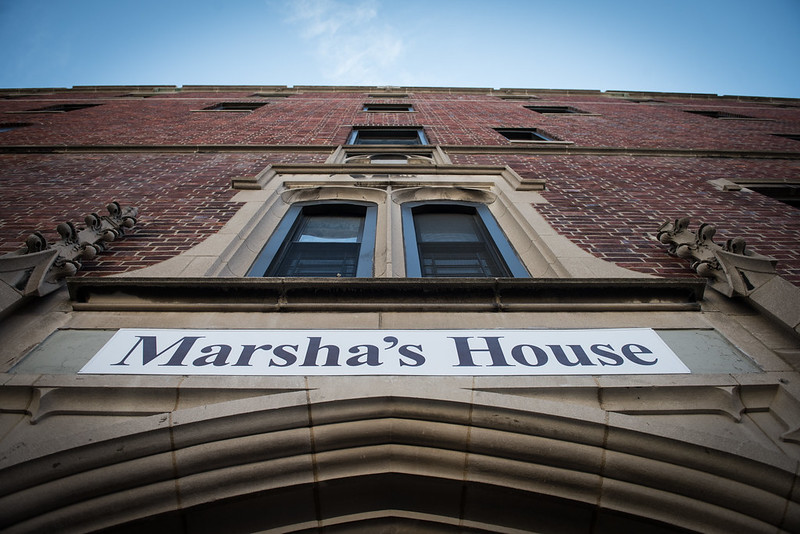
Housing is the focus (photo: Michael Appleton/Mayor's Office)
Over the next several months, New York City will continue deciding how to disperse roughly $34 million in federal Community Service Block Grants (CSBG) and related funds that are available for the current period. However, at this juncture, the magnitude and intensity of the COVID-19 pandemic’s effects suggest strongly that going forward the money should go to community-based groups focused on meeting two urgent needs: relieving hunger and preventing homelessness.
CSBG funds are made available under a federal program that has existed nationwide since the 1960s War on Poverty. In New York City, determining how to spend them involves collaborative work between 41 Neighborhood Advisory Boards (NABs), designated as “representatives of the poor,” and the Community Action Board (CAB) under the supervision of the City’s Department of Youth and Community Development (DYCD). The work typically begins with a roughly four-month long triennial exercise known as a Community Needs Assessment, an information-gathering and analysis process by the NABs of their communities. Ultimately, requests for proposals (RFPs) to address those needs are issued by the DYCD to community-based service-providers, based on the findings of these assessments.
The most recent Community Needs Assessment wrapped up in the autumn of 2019, and the NABs had submitted their recommendations to DYCD shortly before the pandemic struck the city in March 2020. For the past eight months, the issuance of RFPs based on these recommendations has, like much of life in New York City, been in limbo. They’re now expected to go out in the next couple of weeks; a realistic timeline for disbursing funds is perhaps the fall of 2021, or even later.
In preparing the RFPs and in evaluating the responses to them, DYCD should give added weight to meeting the city’s hunger and homelessness emergencies over less-pressing demands.
First as to hunger: According to the nonprofit organization Feeding America (perhaps the nation’s largest hunger relief organization), by the end of 2020 an estimated 19% of New York State residents will be struggling to put food on the table. That’s up from 11% in 2018. Feeding America also expects a greater rate of food insecurity to persist well into the post-pandemic period. This worsening hunger scenario is also confirmed by the experiences of non-profit organizations such as Staten Island’s Project Hospitality, which lately has reportedly been distributing about 2,000 meals a week across that borough, and Manhattan’s Urban Outreach Center, which regularly feeds many hungry people from all across the city. Ominously, the ranks of the food-insecure include college students, single mothers, new immigrants, and homeless or displaced young people.
The immediate and long-term outlook on homelessness is also grim. At mid-November, New York City’s daily headcount of people in homeless shelters hovered around the 54,000 mark. There is little doubt that number will rise dramatically if existing eviction and foreclosure moratoriums lapse at year’s end. Even if extended, it’s just a moratorium: tenants, many of them deprived of income during the pandemic, will still eventually owe all their back rent. Absent emergency federal help to tenants, the city will, in the recent words of New School housing policy expert Alex Schwartz, “experience a rise in homelessness the likes of which we’ve never seen before.”
Making the specters of both hunger and homelessness even worse is the fact that there are many thousands of previously employed undocumented immigrant city dwellers who were unfortunately left out of the federal COVID-19 stimulus assistance payments who have now tumbled into poverty.
There is no need to start from scratch in addressing these problems. For instance, hunger alleviation services could be boosted in the various programs where they already exist, such as in family support programs touching on nutrition assistance or in runaway and homeless youth programs that furnish food, clothing, and even shelter assistance to its clients. The same goes for housing assistance programs focused on landlord neglect and foreclosure prevention. Such programs also have the ability to refer clients to city agencies in situations where the needs of clients fall outside their portfolios – for instance, cash assistance for renters, which can be available through the city’s Human Resources Administration.
It’s also essential that the program partners who are contracted to provide the services have solid on-the-ground experience with the tasks to be undertaken. This can no doubt be accomplished via appropriate qualifying specifications for prospective service-providers.
Let me end with two caveats. First, this is a prescription for fighting extraordinary conditions. After the worst effects of the pandemic dissipate, CSBG grants can be reallocated to address a wider range of needs. And second, we should all recognize that $34 million certainly isn’t enough to slay the two-headed monster of hunger and homelessness in poor neighborhoods throughout the city. But by putting it in the right hands of community-based organizations with proven track records, it can make a real difference. In the current emergency, this is what we need to do.
***
Carl Unegbu is a lawyer and Vice Chair of the Neighborhood Advisory Board (NAB) 12 in Manhattan. The views expressed here are those of the author alone and do not in any way represent the opinions or position of any entity or agency, including the Neighborhood Advisory Board and the Department of Youth and Community Development (DYCD).
***
Have an op-ed idea or submission for Gotham Gazette? Email This email address is being protected from spambots. You need JavaScript enabled to view it.
Support Mink Farmers, Don’t Attack Them, As They Work to Protect Their Animals from Covid Risk

Farmed mink peeking out of its nest box (Truth About Fur)
Since it was learned that COVID-19 can pass from humans to mink, farmers in the United States have put in place strict biosecurity protocols to protect their animals, their families, and public health. But instead of supporting farmers through this difficult period, animal activists -- like Priscilla Feral, who wrote about "The Covid Mink Slaughter" in these pages last week -- are fanning fears that new mink-specific variants of the virus could reduce the efficacy of vaccines, and are calling for a ban mink farming and the sale of all furs.
In fact, public health authorities do not support such extreme measures. After concerns raised in Denmark led to the culling of mink there, the European Centre for Disease Prevention and Control concluded, in November, that the risk to human health posed by mink-related variants of SARS-CoV-2 is low for the general public.
Similarly, leading U.S. virologist Dr. Anthony Fauci said, “It does not appear at present that the mutation that has been identified in mink will affect vaccines or the immune effect of vaccines.”
Rather than culling – let alone an end to mink farming -- the USDA, the CDC, the U.S. Veterinary Diagnostics Lab, State Veterinarians, and other authorities recommend precautionary measures, including employee screening and testing, PPE, and restricted access to the animals. This is exactly what mink farmers are doing, in close cooperation with their state agriculture and health departments.
The real goal of some animal activists, however, is not to protect farms, but vegetarianism and the elimination of all animal agriculture. The real issue, some like Feral argue, is that “humans continue to treat animals as a means to a human goal and not sentient beings worthy of their own rights to live their natural lives undisturbed.”
The problem for animal activists is that most Americans do eat meat and dairy, and wear leather, wool, and other animal products. So fur is seen as a convenient thin edge of the wedge, and mink farming is condemned as “cruel” and “unnecessary”.
Cruel? U.S. mink farmers work hard to provide their animals with excellent nutrition and care, as this is the only way to produce the high quality fur that the U.S. is known for. Mink farmers follow strict operating guidelines developed by veterinarians, animal scientists and animal-welfare authorities to ensure the health and welfare of their animals.
Unnecessary? Fur today is sustainably and responsibly produced; it is a hand-crafted, long-lasting, and biodegradable, natural clothing material.
By contrast, the fake furs and other synthetics proposed by animal activists are generally made with petroleum, a non-renewable and non-biodegradable resource. These synthetics leach millions of micro-particles of plastic into our waterways each time they are washed; plastics that are now being found in marine life around the globe. Cruelty-free indeed!
Mink are raised on small, family-run farms, supporting employment in rural communities. Mink are fed leftovers from our own food production, the parts of cattle, poultry, and fish we don’t eat, and that might otherwise end up in landfills. Mink manure and remains are composted to produce organic fertilizers, completing the agricultural nutrient cycle.
As for the new risks posed by COVID-19, mink farmers take their biosecurity responsibilities very seriously, to protect their livelihoods, their animals, their families, and their communities.
When swine flu and avian flu were detected on farms, we didn’t ban pork or chicken production; farmers and health authorities worked together to responsibly resolve the problems. And that is exactly what we are doing now.
No one forces anyone to wear fur or leather, or to eat meat or dairy. But this does not give animal activists the right to attack the reputations and livelihoods of farm families. This is a time when we should be supporting farmers, not attacking them.
***
Alan Herscovici is Senior Writer & Researcher at Truth About Fur. On Twitter @TruthAboutFur.
***
Have an op-ed idea or submission for Gotham Gazette? Email This email address is being protected from spambots. You need JavaScript enabled to view it.
What Covid and the 2020 Elections Taught Us: It’s Time to Do Right by New Yorkers on Health Care
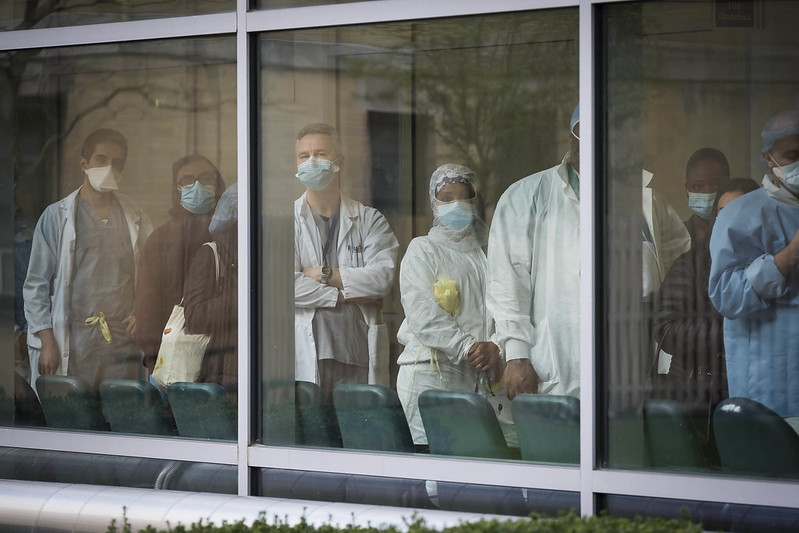
Health care remains the top issue for voters (photo: Ed Reed/Mayor's Office)
The Biden-Harris victory is great news and a huge relief. Our country has suffered under Trump.
But we have a problem. A record number of voters rejected a national campaign that stood for greater economic fairness, science-based policies on COVID-19 and the environment, protecting health care coverage, and racial justice.
In New York state legislative races, moderate and progressive candidates did well, achieving strong legislative majorities for Democrats in both houses. But several challengers as well as good incumbents running for re-election lost or won in races that were real nail-biters. After all we went through with Trump, these candidates, and others, should have had stronger results.
As we look forward, we need to ask: What’s wrong, and how do we fix it.
Many working people across the country, in every demographic group, are disillusioned. They believe many of our political leaders are too close with corporate interests and fail to fight on vital kitchen-table economic issues.
Many people have been swayed by campaigns that make dishonest accusations and exploit divisive issues and fears.
But that doesn’t mean they can’t be won back or for the first time, to support policies that would make a real difference in their daily lives and futures.
To achieve that, I believe we must strengthen our progressive message, not move away from it.
Opinion polls have long told us that health care is the number one issue for the most voters. And while the Affordable Care Act has done a lot of good, COVID-19 has further exposed the gaping shortfalls and gross inequality that plague American health care.
Three quarters of our neighbors are afraid that they cannot afford their health care or health coverage and fear medical debt. Each year, a third of families who have health coverage have a household member who goes without needed health care because of cost; their health coverage doesn’t do the job.
We don’t have real choices. The vast majority of employees are covered by a health plan that’s tied to their job. Health plans impose rising premiums, deductibles, and copays, and we have to pay them if we want to keep our insurance. Health plans dictate which doctors, hospitals, and medicines they cover. And they impose the same costs whether you’re a multi-millionaire CEO or a receptionist.
If you lose your job, which has happened to millions of people, you lose job-connected health coverage.
Access to health care is diminishing. Losing hospitals, doctors, nurses, and neighborhood pharmacies is a growing problem in many communities, including rural areas, in large part because “third party payers” (i.e., health insurance companies) underpay them or exclude them from their restrictive provider networks.
We need to deliver a health plan that by law guarantees everyone complete coverage; complete choice of doctors, hospitals, and other health-care providers; and is funded based on ability to pay. It should include long-term care (home care and nursing home care), which can be a frightening cost that can wipe out a family’s lifetime savings.
In New York, this means the New York Health Act to establish universal single-payer health coverage. It’s more comprehensive than any health plan available. Having us all in the same boat – rich and poor alike – is the best way to guarantee it’s the best possible plan.
Passing the New York Health Act is the one best thing we can do for the health and family finances of almost every New Yorker.
Does the covid recession mean we can’t afford it? No.
Taking insurance companies out of the picture will save New York $55 billion a year we now waste on insurance company bureaucracy, marketing, and profit; on administrative costs doctors and hospitals spend fighting with insurance companies; and on the excessive prices we pay to drug companies because no single insurer has enough bargaining clout to force prices down.
These savings would enable us to cover the uninsured and cover what New Yorkers now spend on deductibles, co-pays, out-of-network charges, and other out-of-pocket costs. Instead of premiums, the New York health plan will be funded through a broad-based tax based on ability to pay.
It will simplify an excessively complicated and convoluted system, for patients, health-care providers, and employers, while providing universal health coverage for all New Yorkers, regardless of ability to pay and not attached to employment.
The New York Health Act has passed the State Assembly four times. We need to do it again and get it through the State Senate. New York’s health depends on it.
***
Assemblymember Richard N. Gottfried represents parts of Manhattan and is the chair of the New York State Assembly Health Committee. On Twitter @DickGottfried.
***
Have an op-ed idea or submission for Gotham Gazette? Email This email address is being protected from spambots. You need JavaScript enabled to view it.
Creating a New Hub to Protect and Empower Brooklynites
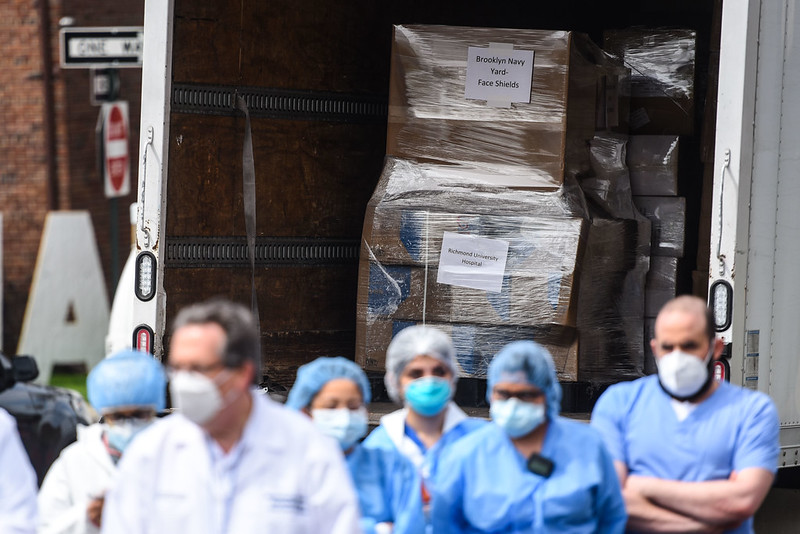
Supplies arrive in Brooklyn (photo: Michael Appleton/Mayor's Office)
Every neighborhood in New York City has been touched in some way by the COVID-19 pandemic. But due to longstanding disparities in our health-care system and structural economic inequality, communities of color have been more susceptible to the virus and more vulnerable to its consequences.
One of these consequences was the distant and dysfunctional health-care supply system, which left safety net hospitals like One Brooklyn Health, which serve and employ the city’s most vulnerable, without the personal protective equipment and medical supplies necessary to keep both patients and staff safe. While President-elect Biden has made clear his team will take an aggressive stance to fighting the virus, the surge in cases in our city is proof that we must act now to prevent another massive calamity. That is why Brooklynites are coming together now to address the structural impediments to local, quality health care.
Building on years of partnership, a rich array of organizations have come together as Brooklyn Communities Collaborative (BCC), united under the common goal of improving health and wealth, and precisely addressing the conditions that have left too many Brooklynites at the mercy of the virus. BCC’s founding anchor institutions include the One Brooklyn Health System, Maimonides Medical Center, the City University of New York (CUNY), and a new social enterprise entitled Citizen Share Brooklyn.
A key aspect of BCC’s work is the anchor mission approach, which calls on institutions rooted in their local community, such as universities and hospitals, to fully harness their economic power through hiring, purchasing, and investing to inclusively and sustainably benefit the long-term health and wealth of their communities.
To leverage the economic power of these anchor health-care institutions, which spend billions of dollars annually on goods and services, BCC and strategic partner Citizen Share Brooklyn will be launching the Brooklyn Health Enterprise Hub — a borough-wide regional health-focused workforce development and enterprise ecosystem.
Comprised of key stakeholders in the health-care industry, including 1199SEIU, the New York State Nurses Association, and other labor unions, employers, academic institutions, as well as community-based organizations, the Hub will redirect the supply chain to benefit the local economy, particularly in neighborhoods most affected by structural racism and economic inequality.
Specifically, the Hub will help implement leading workforce engagement, recruitment, and development practices to identify, recruit, and retain top talent in Brooklyn, expand high-quality health services training programs to meet the needs of anchor health institutions, and establish an approach to securing working capital for business launches and business expansions. Taken together, these initiatives will significantly increase local spending by anchor health institutions, thereby creating more local jobs and local profits.
The Hub will also address the challenges exposed during the current crisis, with plans to create a local supply for essential items.
Ultimately, with leaders across various sectors, boroughs and regions, the Hub will advance a progressive reform of the dysfunctional supply chain – one that adheres to the principles of democratic accountability, equity, and community self-governance by investing in local enterprises that promote economic democracy. A reformed health care supply chain must support local workers not just by paying a living wage, but by investing in forms of citizen-based profit-sharing as well as enterprises that will directly address the depression of wealth – which has exacerbated structural economic inequality and contributed to poor health in communities of color.
To truly succeed, any progressive COVID-19 recovery effort must not only bring us back to where we were before this crisis, but also build a reformed infrastructure for health and shared wealth. The Health Enterprise Hub will serve as a national model in response to the racial, economic, and health-care challenges that are currently facing our nation. The next stage of the recovery effort will require us to be courageous and innovative like never before. Only then can we ensure all communities have the same opportunity to live longer and healthier lives.
***
George Gresham is President of 1199 Health Care Workers East. Representative Hakeem Jeffries represents parts of Brooklyn and Queens. LaRay Brown is CEO of One Brooklyn Health.
***
Have an op-ed idea or submission for Gotham Gazette? Email This email address is being protected from spambots. You need JavaScript enabled to view it.
We Must Not Return to ‘Normal’: Seizing Our Opportunity to Rethink Health and Health Care in New York
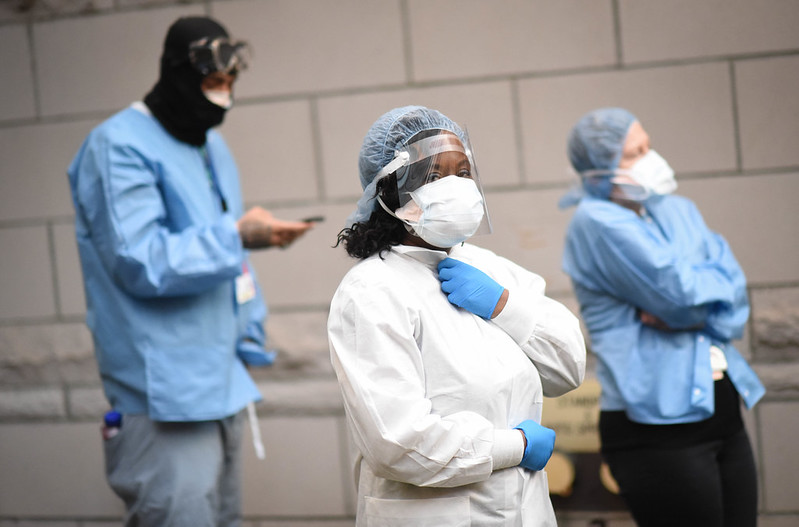
Health care workers during covid (photo: Michael Appleton/Mayor's Office)
Last month, Governor Andrew Cuomo delivered remarks at Riverside Church on the inequities in the Trump administration's COVID-19 vaccine distribution plan. He admirably stated that we must prioritize fairness and equity. Communities like many in the Bronx that have suffered the most because of this virus must not be left behind. But that commitment to leaving no community behind must also be applied to addressing the underlying issues that led to disproportionately negative outcomes for impoverished communities of color impacted by the virus.
Governor Cuomo was right when he stated, ”Covid low tide in America also showed us the deep inequality in our country and the systemic discrimination in this nation. The truth is covid killed Black people in this country at twice the rate of white people. The truth is covid killed Hispanic people at 1.5 times the rate of white people. Those are ugly facts. The covid infection rate was 2.5 times higher among Black and Hispanic people and the hospitalization rate for Black and Hispanic patients was over three times higher compared to white patients.”
This accurately describes our experience at SBH Health System (SBH). For the community we represent, a return to "normal" would be both a disaster and an affront, as it would not address the life and death issues being further exposed by this "low tide" moment in America. According to the New York City Department of Health's COVID-19 database, more than 90% of Bronx residents who have died from COVID-19 had preventable underlying health conditions.
A recent study by Gibenga Ogedegbe, et al also supported the fact that Black and Hispanic populations were more likely to test positive for COVID-19, and although their in-hospital mortality rate was not higher than white patients, “the structural determinants pervasive in Black and Hispanic communities, including inequality in housing, access to care, differential employment opportunities and poverty…explain the disproportionately higher out of hospital deaths due to COVID-19 infections in these populations.”
Moving forward, we know that access to affordable and accessible quality community health care will be a primary factor in addressing the systemic health-care inequities in New York. Without coordinated patient-centered care, it will not be possible to ensure appropriate care continuity. Coordination is key to prevent redundancies and lost opportunities across the entire health-care delivery system, from vaccinations to highly-specialized procedures.
This means primary care clinicians and specialists, ambulatory surgery centers, specialized procedural centers, hospitals, and post-acute care facilities must seamlessly interact on behalf of the patient. We began to see the immediate benefit of this coordination during the height of the pandemic last spring, when hospital systems and others developed collaborative relationships with each other, in concert with public health officials to effect rapid responses to the crisis.
We also know that health and wellness depends not only on healthcare delivery, but also on those social determinants of health that interfere with that delivery. New York must immediately adopt policies that embrace and demand value-based health care. This must include a continued and renewed financial commitment to move health-care delivery from a volume- and profit-driven model to a value-based model that encourages providers and payers to collaborate and focus on programs aimed at improving the health, wellness, and resilience of all communities.
As part of this program, we must preserve the safety net by investing in community-based anchor institutions such as SBH, which has consistently exhibited a commitment to broad-based Bronx community partnerships aimed at improving the lives of the residents of the Bronx.
Our Affordable Housing and Wellness Center Development, in part supported by New York State, is an example of this willingness, and we are proud that we have created opportunities for hundreds of families by investing in safe, clean, affordable, and permanent housing, including for those who were formerly homeless. But it’s not enough.
The Bronx continues to rank 62nd of 62 New York counties in terms of health and wellness, according to the RWD Community Health Rankings. Housing, physical, and food insecurities; education, income, technological, and health-care disparities -- many of them further revealed by the impacts of covid -- must be addressed to ensure that the next pandemic doesn't wipe out the rest of our community.
The moment is now to right the wrongs of previous generations and put our communities on a different trajectory. We have a real opportunity and responsibility to address once and for all the structural inequities that have contributed to the overwhelming losses experienced in our community. New York can serve as a model for the rest of the country about who we are and who we must be, and in the process create a “new normal” that guarantees opportunity and fairness for all New Yorkers.
***
David Perlstein, MD MBA FAAP, is President and CEO of SBH Health System. On Twitter @SBHBronx.
***
Have an op-ed idea or submission for Gotham Gazette? Email This email address is being protected from spambots. You need JavaScript enabled to view it.
Where To Go with Mayoral Control
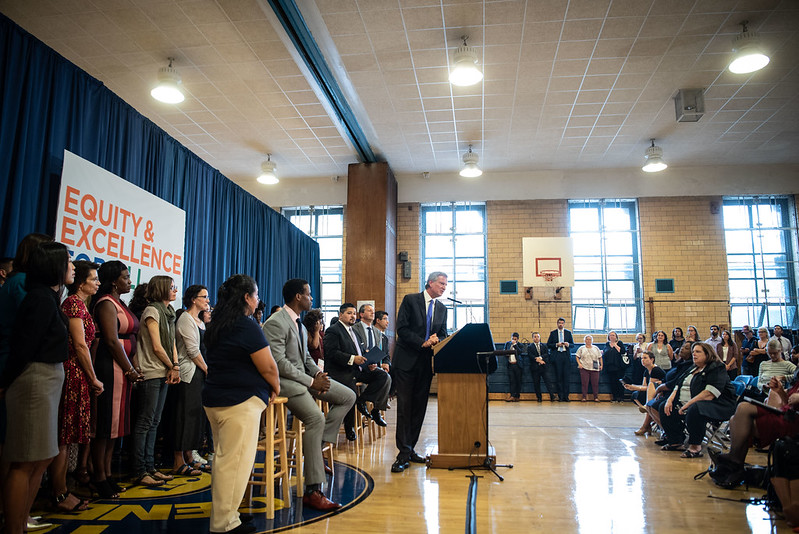
Mayor de Blasio at school (photo: Michael Appleton/Mayor's Office)
Mayor de Blasio's mishandling of the public school pandemic response has led to calls to reform or replace mayoral control of New York City schools.
Almost six years ago, I wrote in these pages advocating the case for mayoral control based on the still-valid theory that quality education depends on maximum funding based on the Mayor's control of the city budget and the need for political accountability to drive instructional improvement. In this way, mayoral control is consistent with the system of elected school board members in districts across the country where elected officials determine the schools' budget and financing, negotiate union contracts, and appoint a Superintendent (our Chancellor). Here, all of those powers reside with the Mayor. Merging fiscal and operational control, once separate provinces of the Mayor and Board of Education, is key to efficient and effective school governance.
But strains on this system, apparent earlier, have become open wounds under Bill de Blasio. He has concentrated power in City Hall rather than delegating decision-making to the educators housed steps away at Department of Education headquarters in the Tweed Courthouse. While the Police Commissioner is allowed a high degree of professional determination over law enforcement, DOE operations under a feckless Chancellor have become an extension of City Hall, with high-level staffers lacking education backgrounds routinely assigned by the Mayor's Office to the Chancellor’s.
Education in the city has become the political pawn of a single individual, unchecked by other governmental structures. This is at least partly because the DOE is not technically a mayoral agency, subject to normal checks and balances by the City Council and Comptroller, but a quasi-independent authority subject to State Education Department regulation. The Mayor's theoretically indirect control stems from his appointment power of the Chancellor and a majority of the Board of Education, re-named by Mayor Bloomberg the Panel on Educational Policy. But de Blasio and, before him, Bloomberg, have redesigned this appointive power to assert autocracy. The City Council has no direct authority over the DOE, relegated to passing reporting requirements rather than statutory controls.
What’s to be done?
Other Models' Weaknesses
I believe there is a better way for mayoral control to work, using a strategic management approach to maintain its budgetary and accountability advantages while delegating instructional policies to educators at Tweed, in the districts, and to parents through parent associations and Community Education Councils. But this opportunity to remake mayoral control may never have been possible and likely has been permanently lost to the closely-held paradigm embedded over the last 20 years by Bloomberg and de Blasio.
The oft-proposed reform of eliminating the Panel for Educational Policy’s mayoral majority with more members with fixed terms appointed by the Borough Presidents, Council, and others is a cure likely worse than the disease. Most recently promoted by teachers' union President Michael Mulgrew, the model is much like the old seven-member Board of Education, which had five members appointed by the Borough Presidents and only two by the Mayor. That system was abandoned in 2001 in favor of mayoral control, an apt testament to its failure to produce either adequate funding or educational quality. In addition, the members' fixed terms allowed them to become independent political actors, without accountability even to their appointing officials.
Replacing an appointed board with an elected body of similar size mirrors many of these same problems through its lack of budgetary and collective bargaining independence, with the additional wild cards of one-person-one-vote seat allocation and the likelihood that our heated education culture wars would produce a volatile mix of political factions, a frequent and paralyzing phenomenon in other districts with resulting operational and educational dysfunction.
Moving further backward in the city's school governance history, community control remains a fervent wish among some, promising a degree of local self-determination never fulfilled after the teacher strikes of 1968. But the demise of community control demonstrates its impracticality. We are one city and bound educationally whether by union contracts, city funding, and most of all the need for city-wide solutions to issues of equity and diversity. Balkanizing control among our still-existing community school districts is a dream at odds with political and fiscal realities.
With these alternatives failing historical and theoretical tests, the key to improving New York City school governance may be hiding in plain sight. As education historian David Tyack pointed out in his classic analysis, there is no "one best system" to solve our educational problems. Each era produces the governance that best fits the circumstances of its time, fitting into its unique socio-political framework.
City Control
When, in 1989, the United States Supreme Court declared the old Board of Estimate unconstitutional, Borough Presidents' budgetary powers were eliminated in favor of the more representative City Council which, until then, had been a mostly vestigial body. In response, the city's elite, distrustful of the newly-empowered Council members, wrote the 1990 City Charter revision to create a strong Mayor system. We live with that system today.
But the Council now is a mature body, having secured public respect over three decades by responsibly exercising its Charter mandates. Perhaps it made sense in 2001, when mayoral control was established, to cut out the largely untested Council from a stronger role in school governance. But today, the measure of the Council has been taken and it has developed a strong reputation for educational advocacy and policy acuity, as well as a culture of consensus that might keep it from the culture wars and procedural paralysis of a less representative, non-mayoral-majority Panel for Educational Policy (PEP). The past two Council Speakers have shown respect for their limited role in education by appointing able Education Committee Chairs who, in turn, held the Mayor to close account through public hearings and greater data-based transparency.
It may be time to reward this record and improve New York City school governance by recasting mayoral control as city control, aligning educational governance with other city services. There are important advantages to this concept, perhaps most importantly to give a powerful voice to individual community interests now lacking in the Mayor's hegemony over the Department of Education or through a slightly enlarged PEP. This check on mayoral power might be the missing ingredient in attenuating executive political interests not by watering them down, as with the Mulgrew plan, but on the constitutional model, balancing executive power with legislative constraints.
The State Education Law establishing mayoral control is already largely consistent with replacing the ineffectual PEP with an independent City Council acting as the Board of Education. Section 2590-g, "Powers and Duties of the City Board," clearly states that "except as otherwise provided by law, the board shall exercise no executive power and perform no executive or administrative functions." Thus, the Council stays in its policy lane, leaving executive functions to the Chancellor and the rest of the DOE in line with separation of powers principles.
Some tweaks and more substantive revisions will of course be needed. For example, the City, not the Council, should be the employer of record for DOE personnel under Education Law § 2590-g (2). As I have suggested elsewhere, the Council should be able to hold hearings before rendering advice and consent over mayoral nominees for Chancellor after a more transparent search process. But how wonderful to put the Education Committee in charge of vetting DOE proposals for "standards, policies, and objectives proposed by the chancellor directly related to educational achievement and student performance"; "regulations proposed by the chancellor"; and "all school closures or significant changes in school utilization," including charter school co-locations under Education Law § 2590-g (1)(a, c, h, respectively). These, as well as other oversight functions, are deserving of greater public scrutiny than possible under unilateral mayoral control.
Advantages and Dangers of 'City Control'
This shared governance largely maintains the related education funding and accountability advantages of mayoral control. Voters would now hold local City Council members responsible, in addition to the Mayor, for fully funding schools. The Mayor could no more pawn off responsibility for education than he or she might try to disown police, fire, or other city agencies subject to similar Council powers. At the same time, with a Chancellor and major policies requiring Council approval, that body could no longer serve as mere gadfly but would have to take ownership of the success or failure of our public schools. By its approving the Chancellor's appointment, Council members would have skin in the game when questioning educational policies, perhaps leading to less adversarial hearings of less heat, more light.
This is not to say that there aren’t substantial dangers in this as yet-untried arrangement, which would be unique in the nation. The Council can be an ungainly body and its new education responsibilities would require a degree of discipline and timeliness not ordinarily found in large deliberative bodies. Particular burdens would fall on the Education Committee Chair to hold numerous hearings and filter reasoned recommendations to the full Council for approval. Grandstanding is a given and the chance of the Council being captured by dominant political interests is also present, though probably not any greater than is currently the case under mayoral control. Most important, the agility of mayoral control to deliver system change could be stymied by ungainly shared decision-making.
Day-to-day operation of the Department of Education would see little change under this arrangement. After all, the current PEP meets only once per month and while its meetings are long on procedure, there are usually few matters of substance, however important. It will take time for the DOE, the Mayor, and the Council to negotiate such new terrain, balancing oversight against micromanagement, promoting educational quality over political expediency.
After 20 years of mayoral control, a fair test of its advantages and disadvantages can be declared though never finalized. There can be no doubt the current system has staunched the school system's previous unaccountable complacency and its pernicious reciprocal weakness, chronic mayoral underfunding. But severe problems of unilateral control and increased politicization haunt today's education policy-making.
Whether more political involvement will improve the situation is an open question. Traditionally, though, the American way of solving this conundrum is checks and balances between elected executive and legislative branches. No governance structure is determinative of sound education policy, but it may be time to adopt this solution by including the City Council's broad representation of popular interests in schools decision-making.
***
David C. Bloomfield is Professor of Education Leadership, Law, and Policy at Brooklyn College and The CUNY Graduate Center. On Twitter @BloomfieldDavid.
***
Have an op-ed idea or submission for Gotham Gazette? Email This email address is being protected from spambots. You need JavaScript enabled to view it.
New York Must Not Exacerbate Disparities Again: Key Considerations for Equity in Covid Vaccination
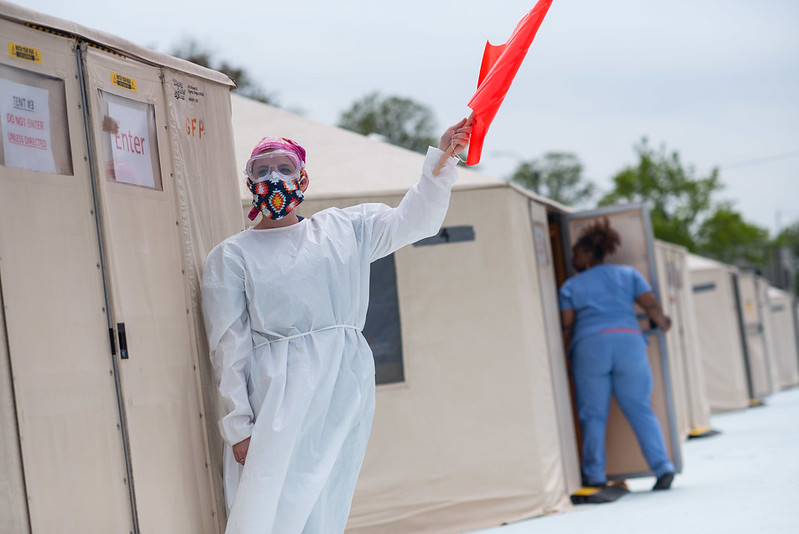
Covid field site (photo: Michael Appleton/Mayoral Photography Office)
There are many high-stakes questions to be sorted out in the design of the coming covid vaccination distribution program. But there’s one issue that’s not receiving enough attention: How can we design a plan that avoids exacerbating pre-existing racial inequities and instead meaningfully advances equity?
It’s essential that we answer this question — now.
Vaccine distribution will be the most complicated implementation challenge of this pandemic, even more so in Black communities and other communities of color. We need to ensure that every aspect of the program is structured to avoid short-changing these same marginalized communities yet again.
Throughout this pandemic, Black, Latino, and indigenous communities have suffered from inadequate and inequitable resources. Hospitals in low-income areas have been under-staffed and under-supplied. Testing has been far more accessible in affluent communities.
Unfortunately, COVID-19 vaccine trials have followed this same disturbing pattern. Black Americans only made up 8% of the Pfizer trial participants. The Moderna trial fared better at 13%. But both fell short of the portion of COVID-19 fatalities among Black Americans: 19%.
Even more worrisome is the possibility that Black, Latino, and indigenous communities could be underrepresented in the early distribution of the vaccine, further exacerbating the pandemic’s racial health inequities.
There is general agreement that early prioritization should go to health-care workers, followed by residents of congregant settings, and then essential workers more broadly. But the way each of these categories is defined has huge implications for equity.
The health-care worker cohort should, of course, include those who directly provide care to patients, like physicians and nurses. But what about the many other job categories in hospitals? Cleaning staff, translators, cafeteria workers, and security guards all have contact with COVID-19 patients. The same is of course true for home health aides. And all are far more likely to be people of color. Excluding them — or any covid-facing worker in a health-care setting — would be profoundly unfair.
Similar questions arise with the congregant setting cohort. Clearly residents and staff of nursing homes should be included in this group. But what about jails, where rates of infection among detainees and staff have been alarmingly high? Or crowded homeless shelters, which are known to be high-risk for transmission? Here again, excluding groups in these more marginal settings would disadvantage populations that are disproportionately people of color.
There are questions about the essential worker cohort as well, which rightly will almost certainly include people who work in transportation or on essential infrastructure such as wastewater treatment facilities. But what about those who work in supermarkets, laundromats, food delivery, or restaurants? These low-wage workers have been performing essential functions throughout this pandemic while exposed to the public — and are far more likely to be people of color. They must be included as well, for their own sake, and for the general public that depends on their work.
Once vaccination distribution moves to a broader public phase, decisions about the locations in which vaccines are administered also have implications for equity. The default option is to primarily use hospitals and chain pharmacies. But there are fewer of both in low-income areas. To reach the broadest number of Black, Latino, and indigenous people, vaccination programs should be set up in a variety of accessible local settings, including churches, community centers, public housing developments, and schools.
It is also critical that there be no barriers to receiving the vaccine based on an individual's immigraiton status. Preliminary plans from the Trump administration would require patients to present a form of ID that is a proxy for citizenship in order to be registered in the vaccination database. This would have disastrous consequences, and cannot be a standard that is used in New York.
And then there is what may be the biggest challenge of all: building confidence in the vaccine among communities that have a century-long history of abuse, exploitation, and neglect by the medical system, in particular around vaccines. Communities of color still experience discrimination and bias in health-care settings today.
To overcome the trust gap, there must be total transparency about COVID-19 vaccine safety, efficacy, and side effects. Additionally, there must be a well-funded, culturally-responsive, multilingual outreach campaign to share this critical information with Black, Latino, and other communities of color. Local community organizations must be mobilized for on-the-ground outreach, at a scale that is more robust than the campaign to promote participation in the Census.
The federal government will be imminently rolling out guidelines on key aspects of the vaccination distribution process. But it will be up to state and local governments to tailor these plans to the needs of their local communities.
It is critical that here in New York City, and across the country, we design a fair and equitable vaccination program that ensures that no one is left behind. Lives depend on it.
***
Dr. Uché Blackstock is a Board-certified emergency medicine physician, the founder and CEO of Advancing Health Equity, and a Yahoo! News Medical Contributor. New York City Council Member Mark D. Levine represents parts of Manhattan and is chair of the Council’s Health Committee. On Twitter @uche_blackstock and @MarkLevineNYC.
***
Have an op-ed idea or submission for Gotham Gazette? Email This email address is being protected from spambots. You need JavaScript enabled to view it.